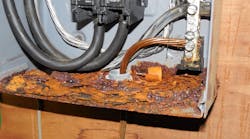How well do you know the Code? Think you can spot violations the original installer either ignored or couldn't identify? Here's your chance to moonlight as an electrical inspector and second-guess someone else's work from the safety of your living room or office. It's your turn to identify the violation.
Hint: Rotten to the core
Find the Answer
Removing this panelboard cover revealed a dangerous situation. Dripping water was apparently a long-term problem for this service disconnect enclosure. The bottom of the enclosure is completely rusted out. The neutral bus is also severely damaged from corrosion. All of this corrosion leads to poor electrical connections, which could result in flickering lights and fluctuating power, and eventually serious arcing and sparking — possibly resulting in fire conditions. In addition to de-energizing the power, fixing the water leak is priority number one so it does not cause a catastrophic short circuit failure. Replacing all of this this equipment would certainly be a good idea too.
Section 110.12(B) prohibits equipment with damaged, broken or corroded parts that may adversely affect the safe operation or mechanical strength of the equipment. This water was coming through the inside the jacket of the SE cable that was used to wire this service. The weatherhead cover was missing at the top of the cable, which allowed water to find its way into the cable and simply follow the wires all the way into the building. Proper drip loops and a correctly installed weatherhead can help prevent this particular problem.




